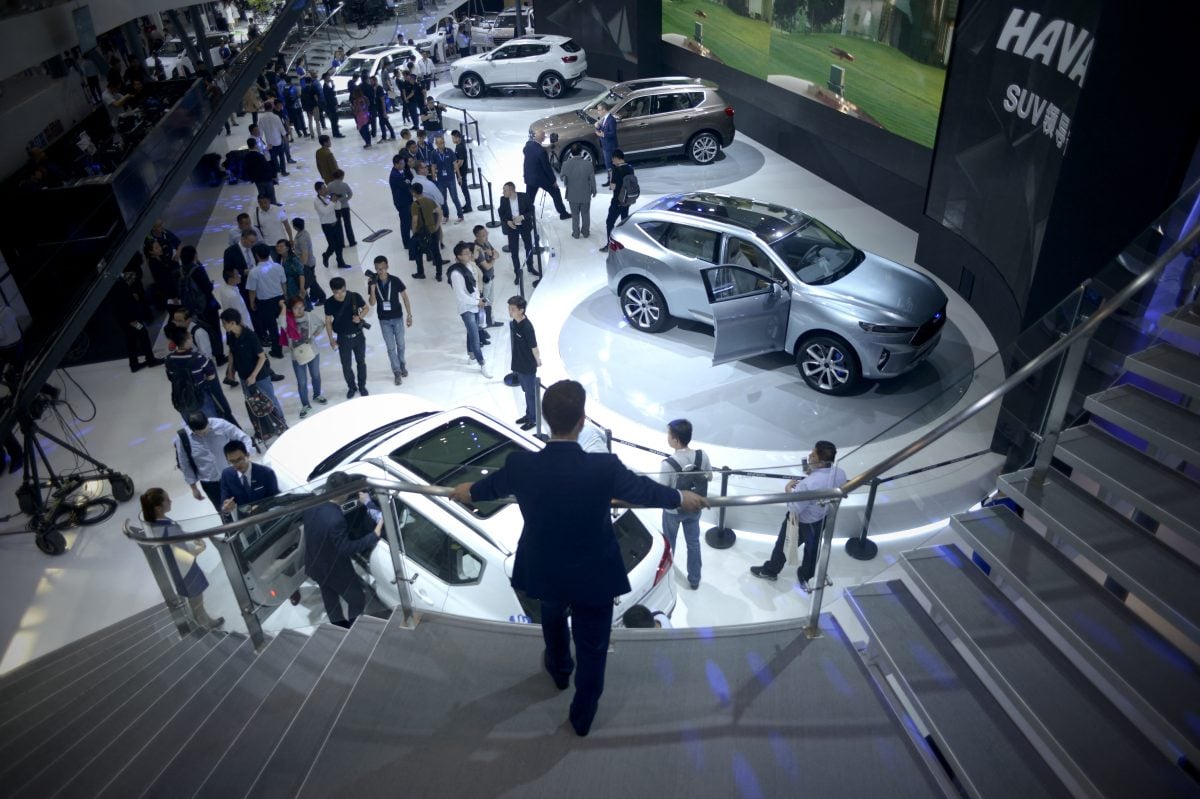If you’re driving in one of South Africa’s cities and find yourself staring at an unfamiliar car logo, you may well be looking at one of the many Chinese cars that are proving increasingly popular among motorists.
Chinese-owned brands have been making major strides in the market’s mid-range segment, where cars are typically priced below the R600,000 ($33,000) mark. In the crossover SUV segment or “compact family cars”, two Chinese brands, Haval and Chery, made the top 10 for new car sales in the first half of 2024, according to South Africa’s Automotive Business Council.
They are also selling well in the SUV segment where cars are priced above the R600,000 mark – data from the council shows that Haval and Chery were the top-selling and third-best selling SUVs from January to November 2023.
So what’s making them so successful in the South African market? According to most analysts, it comes down to two things: price and perceived quality.
“The value proposition with them is just so, so good, so superior to legacy automakers. Chinese brands have a different strategy, the cars come fully loaded, what you see is what you get, and the technology is great,” Ciro De Siena, journalist at Cars.co.za, tells African Business.
“The legacy brands still have a business model where the car will be advertised at a certain price, but by the time you sit down and spec it, getting the things that you want, like a panoramic roof, or 360-degree cameras for example, the price is not the same, it’s maybe around R100,000 extra. A Chinese car will most probably come with those things.”
According to auto journalist and expert Lance Braquinho, the appeal goes beyond the price tag. He argues that Chinese cars have significantly improved since they first entered the South African market late in the first decade of the 2000s.
“Some of the products are very good now. I went to China in 2008, and the cars were not of a high standard if I’m honest. But there were young engineers over there who were very good. All they wanted to speak about was Tesla and German car brands, you could see that, that was their benchmark for quality. That’s what they were working towards, and they are learning faster than anyone else,” he says.
Braquinho reckons that Chinese car brands currently have an edge over competitors in terms of technology, and particularly software integration.
“Carmakers have to be good software engineers these days in terms of making cars. The consumer wants the car to work with their phone apps, you want that immersive experience. Where were the first iPhones built? Many of those engineers have their own companies now. Legacy car brands are increasingly being left behind in that department.”
The price is right
Chinese cars started pouring into the market around 2007 after a period of economic growth in South Africa. But many pulled out during the fallout of the world financial crisis of the late 2000s, and it is only in recent years that they have solidified their foothold.
According to De Siena, Chinese car brands are returning at the right time, with tough economic conditions pushing consumers to “buy down”.
“What’s interesting with the South Africa market is that it used to be very badge conscious. If you had money, you bought a BMW or an Audi. The brand loyalty was massive. In the last 10 years, with inflation, car prices going crazy, the cost of living going up, South African consumers became more interested in value than in badge. South Africa has become a very price-conscious market. Chinese cars came back at the right time; they didn’t have to convince people necessarily to buy into their brand. The Chinese are offering what feels and what looks like quality products at a much more affordable price.”
Brandon Cohen, chairperson of the National Automobile Dealers Association (NADA), agrees that consumers are more price-conscious and therefore prepared to give Chinese brands a go.
“South African middle-class buyers increasingly look for options under R300,000, and with ongoing economic challenges, the appeal of accessible pricing from Chinese brands is particularly strong.”
The South African auto market has not seen major growth in recent years since the pandemic – new vehicle sales increased by only 0.5% year-on-year in 2023 to 532,098 units compared to 529,556 units in 2022. But investors are growing in optimism with the advent of the more business-friendly coalition government; if economic growth significantly improves on the meagre 1.1% projected by the IMF this year, consumers may again be ready to spend on vehicles.
Tariffs
However, there are several challenges facing Chinese manufacturers eyeing up the market. Light vehicles are currently subject to a 25% tariff, while 20% is imposed on original equipment components. A preferential agreement results in imported vehicles from the EU paying only 18% duty. The import duty on medium and heavy commercial vehicles is set at 20% ad valorem; EU manufacturers pay just 12%.
The way to avoid these tariffs would be to manufacture the automobiles inside the country.
But any move to establish local production “would likely require a long-term commitment and significant investment,” says Cohen.
Chinese company BAIC, in partnership with South Africa’s Industrial Development Corporation, launched a manufacturing plant in Gqeberha (Port Elizabeth) in 2018. The plant, costing R11bn ($604.3m), was dubbed as China’s largest investment outside of Europe, but the factory has only produced 300 cars since its opening according to local news reports. By contrast, Ford’s Silverton assembly plant in Pretoria produces 720 vehicles a day, and the US giant said in late 2023 that it will invest $281m to produce hybrid vehicles in the country.
Other non-Chinese brands have already committed significant investment to the country. In April German automaker Volkswagen announced that it would invest $220m in its Eastern Cape plant in preparation for manufacturing a new SUV from 2027. Franco-Italian carmaker Stellantis said in 2023 it had reached a preliminary agreement with South African authorities to build its first plant in the country by the end of 2025. Japan’s Nissan has also invested heavily in recent years.
China’s Great Wall Motors, owner of the Haval, P-series, and Tank brands, has told local media that it is engaging with stakeholders on plans to produce vehicles in the country. But investing in local production is an expensive process, and manufacturers would need to reach a customer base beyond the South African market for it to be profitable.
South Africa-based auto manufacturers currently export to the US, Europe, Middle East, and other African countries, and Chinese brands would likely have to increase their appeal in similar markets to make a South African plant worthwhile. That said, De Siena believes that the African market for internal combustion engine vehicles will become increasingly important for South African manufacturers who have largely failed to adapt their factories to produce electric vehicles so far.
“Demand for internal combustion engines is decreasing in Europe and the US, and in South Africa we are not building NEVs (new electric vehicles). It is hideously expensive to re-tool your factory to build them, so manufacturers are pivoting towards Africa.”
De Siena believes that this might be the ambition of Chinese car brands: “The business play would be to get a foothold in South Africa, sell as many cars as possible, and then start building and exporting into Africa. Africa is seen as a market that will continue to expand.”
Life after 80,000km
Another potential issue for Chinese car brands in South Africa is the public’s perception of unreliability. Since Chinese car models are relatively new to the market, little is known about their long-term performance and durability in a country where long distances and variable road quality are common features.
“The test will come when the cars go out of warranty. And when you see what durability looks like beyond 80,000km. If they become expensive to maintain then you might see the brands take a knock. Being an importer means you have to warehouse a lot of parts. You must ensure you are future-proofed. When the heavy maintenance cycle starts after 60, 80, 100,000km, you will need specialised parts. If you don’t have it, people will start to hate you because their cars might be out of commission for weeks, or even months,” Braquinho says.
Chinese brands are working hard against this perception with generous warranty offers. Recently, GAC Motors became the first in South Africa to introduce a lifetime engine warranty.
Resale value is another core consideration for consumers, and De Siena says that this is a weakness with Chinese brands, albeit one that is changing.
“If you buy a Toyota, you can be sure you will get a lot of your money back when you sell it, or trade it in, whereas Chinese vehicles in the past have depreciated more than the legacy vehicles. However with a lot of demand for Chinese cars in the market, the resale values are creeping up. Increasingly customers will lose less on their purchase, which will make Chinese cars even more attractive.”
Electric vehicles
Meanwhile, China is also gaining ground in the global electric vehicle market. Data from the China Association of Automobile Manufacturing showed that in the first nine months of 2024, China’s total EV output reached 8.3m units, up 31.7% compared to the same period last year. Meanwhile, the country’s EV exports reached 111,000 units in September, up 0.9% from the previous month and 15.6% from a year earlier.
In February, the Alliance for American Manufacturing said that low-priced Chinese EVs in the US could be an “extinction-level event” for America’s auto industry. In May, the Biden administration increased its tariff on Chinese-made EVs from 25% to 100%, citing “extensive subsidies and non-market practices”. In October, the EU increased its tariff to as much as 45.3%.
China’s BYD Auto, the largest EV manufacturer in the world, entered the South African market last year and released the Dolphin model this year at R539,900, making it the cheapest EV in the country.
The South African government has recently indicated that it is looking to incentivise electric car manufacturing locally. It currently imposes a 25% tariff on EV imports. However, Braquinho says “there’s not a big demand for pure EVs at the moment” with importers facing several challenges, not least a lack of charging infrastructure and unreliable power supply given national load shedding.
Braquinho expects only limited inroads in the EV market from China and other manufacturers.
“99% of bakkies [pickup trucks] are diesel, for a reason. It’s available everywhere, has a high power density, and it will run forever if you maintain it properly. Chinese brands are learning that the market wants diesel machines,” says Braquinho.
Penetrating the premium market
An alternative outlet for growth could be premium vehicles. Trying to penetrate a market which places less of a premium on price could be the ultimate test for Chinese marques.
A precedent could be the arrival of Korean car brands to South Africa in the mid-1990s. Kia and Hyundai started as budget cars, but as they built a reputation for quality, their prices started to increase.
Today, Kia and Hyundai are making cars priced over the million rand mark and enjoy a strong customer base in the country.
“Chinese brands may face greater challenges in penetrating the premium vehicle segment, which typically values unique differentiators, specifications, and brand prestige,” Cohen says.
Want to continue reading? Subscribe today.
You've read all your free articles for this month! Subscribe now to enjoy full access to our content.
Digital Monthly
£8.00 / month
Receive full unlimited access to our articles, opinions, podcasts and more.
Digital Yearly
£70.00 / year
Our best value offer - save £26 and gain access to all of our digital content for an entire year!

 Sign in with Google
Sign in with Google 



